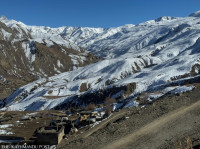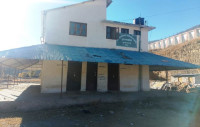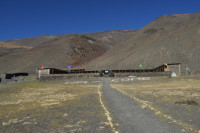Karnali Province
Logs worth millions of rupees are rotting in community forests, but locals can’t buy them due to legal hurdles
The prohibition on felling shorea robusta trees has complicated the sale process, even for those toppled by wind, old age, or other disasters.
Biplab Maharjan
Suresh Gaha Magar, a resident of Damdawali in ward 5 of Kalimati Rural Municipality, and a member of the consumer committee of the Triveni Community Forest of the rural municipality, completed construction of his house a couple of months ago. However, he faced difficulty finding timber for his new house.
“Even though there are nine community forests in the rural municipality, I had to buy timber from neighboring Dang district to build my house. The high transportation cost compelled me to use steel in several parts of the house, such as the windows and doors. Steel was expensive but not as expensive as timber,” said Magar.
Kalimati Rural Municipality is a remote rural municipality with minimal development, surrounded by forests and hills with difficult topography. The majority of the trees in the forests and hills are sal (shorea robusta) and saj (terminalia tomentosa).
Logs worth millions of rupees are rotting in the community forests of Kalimati Rural Municipality. The community forests collect fallen trees and pile them up and sell them. But owing to the long bureaucratic process of selling the logs and disputes between community forest user groups and contractors, the precious logs are rotting in the piles. Revenue of millions is being lost every year as the community forests are unable to sell the timber.
According to the rural municipality, most of the logs were from old fallen trees and the trees that were felled while carrying out development activities including roads.
There are seven wards and 65 community forests in the rural municipality. The total area of these forests is about 3,000 hectares with hardwood trees, mostly sal and saj. Around 10,000 logs have been piled up in nine different community forests in wards 4, 5, 6, 7 and 9.
According to Purshottam Bhattarai, Salyan chief of the Federation of Community Forestry Users Nepal, they have started a tender process to sell just around 4,000-5000 cubic feet of logs that have been piled in the national forests.
“After the government passed a law prohibiting the cutting down of sal trees and the sale of fallen trees in disasters, even the community forests have not been able to sell fallen sal trees. The government has implemented strict action against those who buy and sell sal trees,” said Bhattarai.
According to Chandra Bahadur Gaha, chairman of Triveni Community Forest in the rural municipality, 5,500 cubic feet of sal and saj logs, which are lying in the forest, are rotting because they cannot be sold due to bureaucratic and legal hurdles.
“The forests of the whole rural municipality are covered with mostly sal trees, and due to the ban on buying and selling timber, we have not been able to sell the logs to the locals, despite having a quota for selling a certain number of logs at discounted prices. Because there are mostly sal trees, we face problems selling the other trees, such as saj, due to which there is very low revenue generation,” said Gaha.
“Due to low revenue, we haven’t been able to improve and secure the forest, as well as control human-animal conflicts. We rely completely on the government budget for essential tasks, such as planting saplings and providing compensation to families affected by wildlife in the forest,” Gaha added.
It is not like the trees were illegally cut down. Most of them fell due to natural causes like wind, old age, and collapsed during natural disasters. The community forests never have enough budget to control forest fires during the dry season, said Gaha.
According to Tekraj Pulami, chairman of ward 6 of Kalimati Rural Municipality, the locals should have priority access to the forest materials, but as most of the logs are from sal trees, locals are unable to obtain quotas for buying logs at lower prices.
“Legal hurdles make it difficult for consumers to obtain timber even for building houses. Also we cannot get any timber for building suspension bridges or wooden bridges. We cannot even use collapsed and fallen sal trees for development work,” said Pulami.
Dan Bahadur Khatri, chairman of Kalimati Rural Municipality, said that despite efforts by the rural municipal office to obtain permissions from the district, province, and center to sell the logs, they have been unsuccessful every time due to the years-long approval process.
“After facing multiple rejections from the provincial and federal levels, we have given up efforts to convince the higher authorities to allow us to use the trees or sell them. The cost of a 10-foot door is Rs16,000 and a 5-foot window is Rs10,000,” added Khatri.
Jitendra Mahat, chief of the Division Forest Office, Salyan, said despite being surrounded by sal forests, local residents are unable to benefit from them due to the government rules that bar felling and selling of sal.
“To sell any sal tree, we have to obtain permissions from the provincial and the federal governments and this takes a year. Due to the lengthy process we have not been able to benefit from the nine community forests,” Mahat added.




 13.12°C Kathmandu
13.12°C Kathmandu











